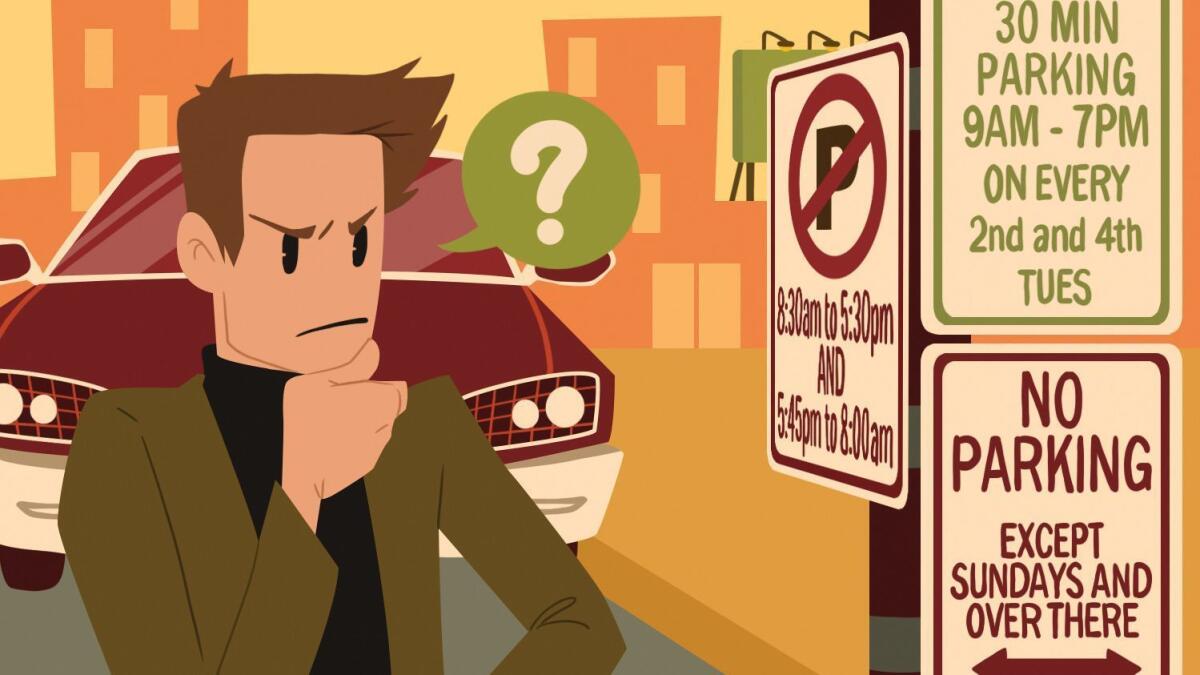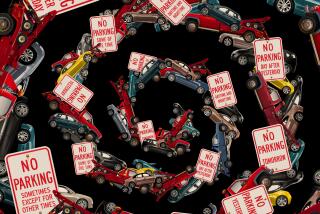Having problems finding parking on vacation? An app may be the answer

- Share via
Riddle me this, travelers: When is a car not a car? When it’s an albatross. I thought my crummy rental was a car and not a South Seas winged creature as I whizzed south toward San Diego for a weekend. But that was before I tried to find parking.
Rental cars are a $30-billion-a-year business in the U.S., according to statistics from Auto Rental News. Some travelers have ditched the car and are using ride-sharing services or public transportation, but that doesn’t seem to have affected rental revenues, which grew by more than $1 billion from the previous year.
Sometimes it makes sense to have a car for destinations that aren’t within the scope of buses, trains, trolleys or other public transport; to cover a lot of ground quickly; or to lug a lot of equipment. And that’s when a car becomes a ball and chain.
But there are systems to help you find a parking space, and we’re just starting to see them in airports and other destinations frequented by travelers.
For airport parking
Ontario International Airport in the Inland Empire (booking.flyontario.com) and San Diego International Airport (san.org/Parking) now offer on-site parking that you can reserve and pay for in advance. (At LAX, private lots may let you reserve, but airport-controlled parking reservations are still in the offing.)
Being able to reserve an airport parking spot online is more common abroad. “It is true that the U.S. … is a fair way behind,” said Theresa Hughes, chief executive of Chauntry. Its website describes itself as the “world’s most successful parking reservations system.”
Reserved parking has a revenue benefit, although not always for the customer: As with airline tickets, demand may influences prices.
Price aside, here are some tips, for close-to-home and farther away.
For urban parking
If parking is such a problem, why not just add spaces? For one thing, they are expensive to build. For another, they require maintenance. What’s really required, said Steffen Turoff, who manages the L.A. office of Walker Consultants, a parking consulting firm, is better management of those spaces.
“If you look just about anywhere, everybody is parking up front, and the spaces and bottom level on the edges are always empty,” he said. “You can keep adding but you don’t solve the problem.”
An app that tells you what’s available where and for how much will let you manage your time and the parking company manage its space.
A company called Parking Sense and its technology are the forces behind a guidance system that vows to lead you to the promised land of reserved parking. It claims that it can cut the time it takes to find parking by as much as a half-hour. Plus by not driving around looking for a spot, you’re reducing auto emissions.
ParkUp Pay’s app lets you find parking and know the cost before you commit to a spot. It has 87 parking sites in the L.A. area and will add 140 more in the next 12 months, said Jack Bezzant, the chief executive of the company whose goal is to make “parking as reliable as electricity.”
It’s not the only game, of course. I found ParkWhiz and asked it to find a spot near our old L.A. Times offices downtown. It came back with a spot that cost $5 and was a one-minute walk.
SpotHero, which said that the 85 hours that L.A. drivers waste looking for parking costs $1,700 a year, found a $5 spot six-tenths of a mile from Dodger Stadium for the home opener against the Arizona Diamondbacks at 1:10 p.m. March 28.
Parking Panda found an $11 place just two-tenths of a mile from the Santa Monica Pier. It would, as many apps will, let me use my phone for my mobile pass. Some also allow you to use Apple Pay.
There are many more, and you may need to try several, depending on your destination, because not every company is in every city.
Create a car parking strategy
When you decide to travel with a car, keep in mind the parking triangle maxim.
The parking triangle, Turoff said, means that parking can be cheap, it can be convenient or it can be plentiful. “It’s always two of the three,” he said. “It can’t be all three.” Some factors to think about:
►Consider how you’ll be using the car. If you need it to reach the hinterlands of your destination, park farther away from where you are staying. That way, you get the cheap or the plentiful, but you will pay in inconvenience. That may not be as difficult if you’re not having to hoof it to your car every morning.
►For getting around town, Turoff said, consider public transportation, bike share or the scooters that everyone hates but are inexpensive and convenient.
►If it’s convenience you want, be prepared to pay. It’s why I recently forked over $38 for one night of parking at a hotel on the edge of San Diego’s Gaslamp Quarter — not as expensive as some overnight parking I’ve experienced but not a very good use of dollars for a 12-hour stay.
At my second hotel that weekend, my parking ended up being cheap and convenient — a win. I wish I could say my strategy had paid off, but but I had not even asked about hotel parking.
I arrived after dark, parked in the loading zone (30 minutes), schlepped my stuff inside, checked in and asked as sort of an afterthought about hotel parking. There was none.
“Street parking,” the hotel clerk said. It took me several moments to comprehend what she was saying.
I hadn’t yet been educated about apps so I held my breath, walked out into the night and circled twice, three times and then pay dirt. A space on the street.
Street parking is a sought-after commodity, Turoff said, but it’s also a finite resource. It’s high demand and it has high turnover because of time limits, which makes it a not-so-great substitute for a hotel lot. If that’s your only choice, you may not find your car in the same condition in which you left it.
I must admit that I had hit on two of the three parking points Turoff mentioned — the cost for 11 hours of parking: nothing. The convenience: two blocks to the hotel.
When I returned to the space the next morning, the car was there and in one piece. I was lucky, but in my deepest, darkest heart, had it been my own vehicle, I never would have left it there.
What I realized is that you have four important tasks if you’re traveling by car:
►Figure out whether the car is really needed or it’s California culture doing a tap dance on your brain and thus your budget. Do you really need a security blanket on four wheels?
If the answer is yes:
►Find out ahead of time where to park. Call the hotel or attraction or use an app. Don’t just wing it; ask for help (“Know any secret spots nearby?”).
►Decide how much you’re willing to spend and figure it into the travel budget. Parking is one of the hidden costs of travel that we forget to account for and it can be a budget buster, whether it’s at a hotel, a museum or the airport.
►What can you live with? Weigh the convenience of your parking spot versus the possible theft or damage to the car if it’s not left in a protected lot.
Being a brighter and better traveler isn’t just about knowing the best restaurants and seeing the most interesting places. Sometimes it’s knowing that how you roll can make or break a trip.
Now about those Bird scooters …
Have a travel dilemma or question? Write to [email protected]. We regret we cannot answer every inquiry.
More to Read
Sign up for The Wild
We’ll help you find the best places to hike, bike and run, as well as the perfect silent spots for meditation and yoga.
You may occasionally receive promotional content from the Los Angeles Times.







